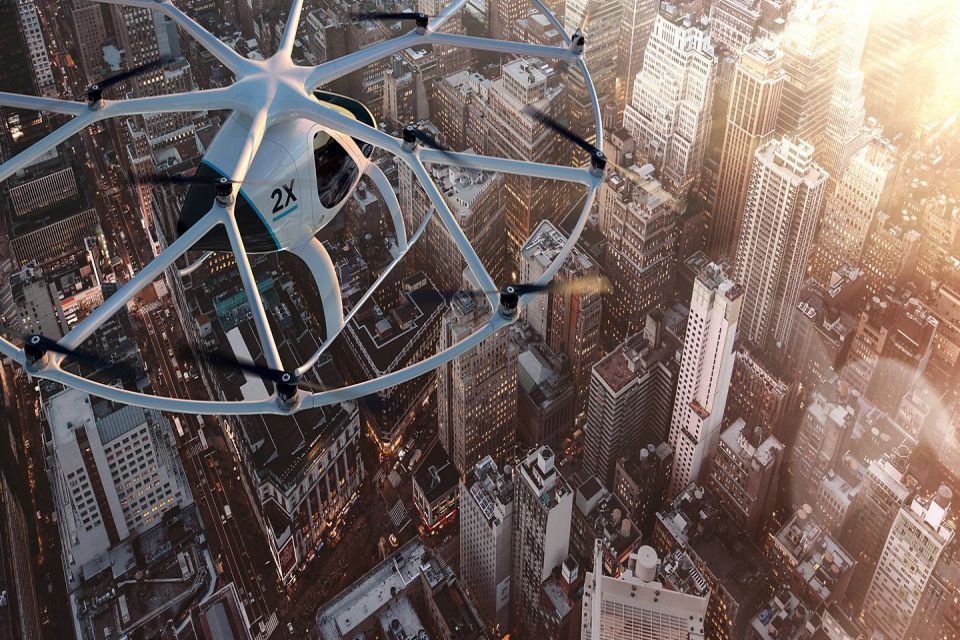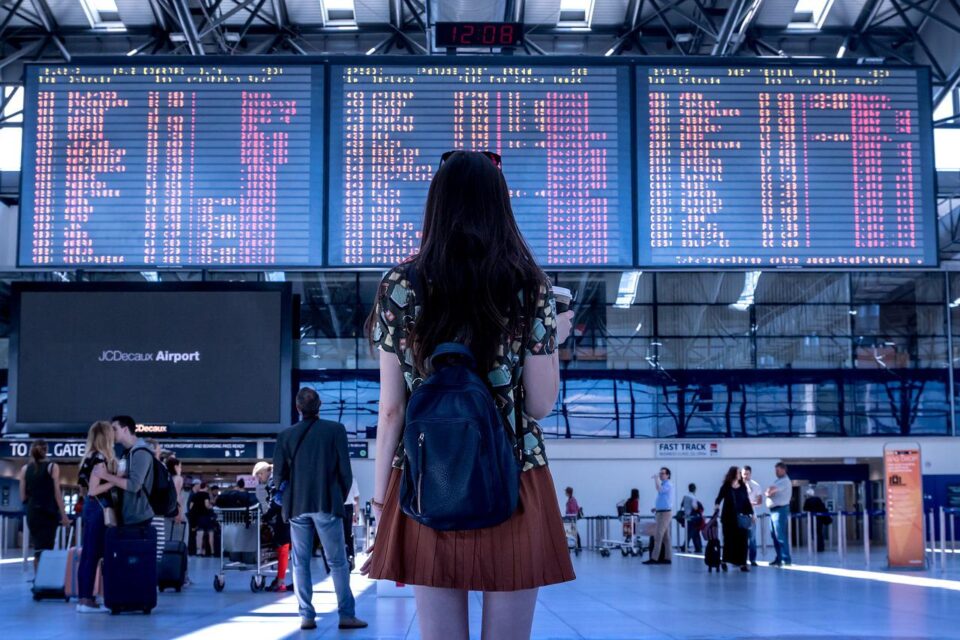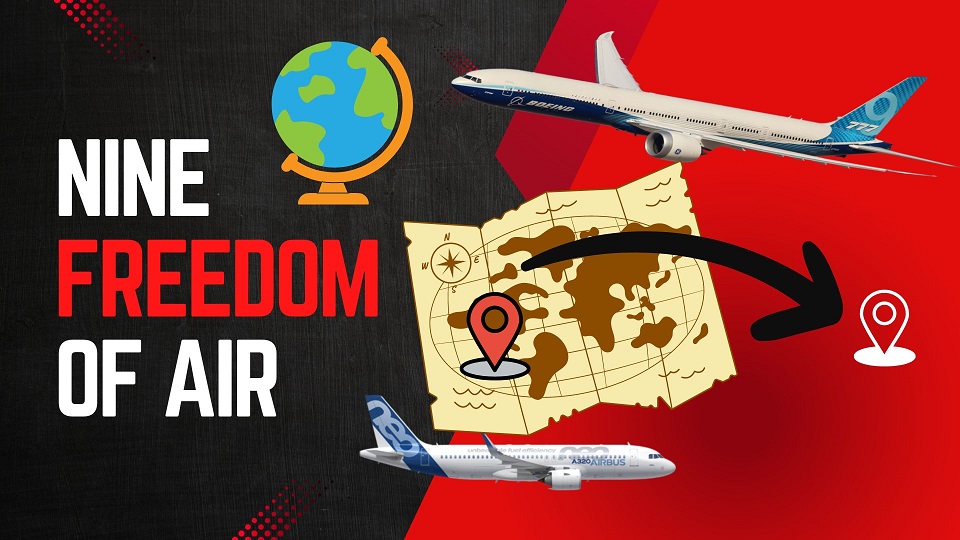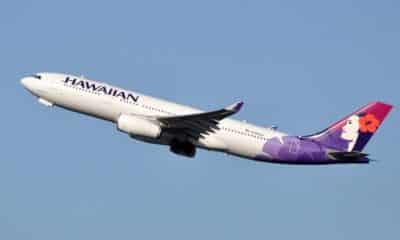Aviation
How Volocopter’s ‘flying taxi’ stations will be running by 2028

How Volocopter’s ‘flying taxi’ stations will use an elaborate system of conveyor belts and lifts to handle 10,000 passengers each day by 2028.
The future of travel has been unveiled by Volocopter – and it seems remarkably efficient. The German flying car start-up has released a video that shows its vision of an urban ‘air taxi’ system that could handle 10,000 passengers each day. The system features elaborate ‘Volo-port’ stations perched on top of skyscrapers that are equipped with conveyor belts, swappable battery packs and lifts to speed up transfer of passengers. This means aircraft are always fully charged and ready to go, according to the company, which claims these futuristic landing pads could be commercially viable for normal people. The company hopes to have a prototype station in place next year but predicts that it will take around ten years before a city-wide system is in place.
The Stuttgart-based start-up’s ambitious plan is to create circular launchpads on the top floor of skyscrapers in cities from where the electric aircraft would take off and land, writes the Verge. They would have a conveyor belt that would transport the vertical takeoff and landing (VTOL) aircraft into an indoor hanger.
From there, they would moved to a garage where maintenance work can be carried out. The system would be so efficient the company claims 1,000 passengers could board and disembark every hour.’It’s about mass transportation of people and how it can be done in a safe way and with what infrastructure,’ Alexander Zosel, Volocopter’s co-founder and chief innovation officer, told the Verge. Mr Zosel said the Volocopter aircraft would need to land every 30 seconds. Having such high volume is important if the company is able to handle lots of passengers and therefore be affordable.
Initially, the taxis would only fly over a short distance with flight times of around 30 minutes and a maximum range of 17 miles (27km). However, some have doubts about how feasible this technology will be – most batteries are still far off offering the power-to-weight ratio required to take off. The company has demonstrated its capabilities in Germany and Dubai where it believed the company is most likely to launch its first service. More recently it announced it partnership with Intel in CES at Las Vegas.
The company stunned attendees during Intel’s keynote by flying the drone right onto the stage, in what a spokesperson admitted was a ‘ballsy’ move. In a presentation about Volocopter’s craft, an exhibitor said it is the ‘world’s first autonomous air taxi.’The craft completed the first unmanned test flight in Dubai this past autumn. ‘Potentially in years to come, you would be able to take your phone out and pull up a transportation application, and similar to what you do with a taxi today, summon this to your location, hop in, tell it where you’re going. ‘And it would autonomously fly you to that location, no pilot required. It’s a safe, reliable form of transportation’, the exhibitor said. The Volocopter craft ‘is essentially a scaled-up super drone,’ he noted. It is fully electric, allowing for zero emission travel. And, it’s quiet enough to be operated in an urban environment.
Volocopter relies on a system of ‘redundancies’ to ensure its safety, meaning there are many propellers, batteries, and motors to compensate in case one goes out. With Intel’s flight control technology and a ‘myriad of sensors,’ the craft is ‘constantly analysing environmental data to ensure those redundancies,’ a Volocopter exhibitor explained.
There are 18 independent motors and propellers, but ‘if that seems like way too many, what it allows for is, you can lose a propeller or several of them and still maintain your flight.’There are nine batteries, ensuring the same type of back-up. According to the firm, rides in the flying taxis would likely be comparable to a trip in an Uber Black.
Courtesy: DailyMail

Airlines
US DOT says Airlines must now pay automatic refunds for cancelled flights

The U.S. Department of Transportation (DOT) has released a final regulation requiring airlines to quickly reimburse passengers with automatic cash refunds when owed, according to a statement made by the Biden-Harris Administration.
Under the new regulation, passengers will find it easier to get refunds when airlines dramatically alter or cancel flights, cause severe delays for checked baggage, or don’t supply the additional services they paid for.
According to a statement from the Biden-Harris Administration, the U.S. Department of Transportation (DOT) has published a final rule mandating airlines to promptly compensate customers with automatic cash refunds when they are eligible. The new rule would make it simpler for customers to receive refunds from airlines in cases when they drastically change or cancel flights, cause significant delays for checked luggage, or fail to provide the extra services they charged for.
Under the latest rule from the USDOT, passengers are guaranteed refunds in several scenarios:
- Canceled or Significantly Changed Flights: Passengers are entitled to refunds if their flight is canceled or significantly altered, including changes in departure or arrival times exceeding 3 hours domestically or 6 hours internationally, departures or arrivals from different airports, increased connections, downgrades in service class, or changes less accommodating to passengers with disabilities.
- Delayed Baggage Return: Passengers filing mishandled baggage reports can claim a refund for checked bag fees if their luggage is not returned within specific timeframes after flight arrival.
- Unprovided Extra Services: If airlines fail to deliver paid extra services like Wi-Fi, seat selection, or inflight entertainment, passengers can request refunds for those fees.
The final rule streamlines the refund process, ensuring it is:
- Automatic: Refunds are issued automatically without requiring passengers to request them.
- Prompt: Airlines must refund credit card purchases within seven business days and other payment methods within 20 calendar days.
- In Original Form of Payment: Refunds are provided in the original payment method used for purchase.
- Full Amount: Passengers receive full refunds minus the value of any portion of transportation already used, including government and airline fees.
Suggest banning family seating junk fees and ensuring that parents can travel with their kids at no additional cost. No airline promised to ensure fee-free family seating prior to efforts from President Biden and Secretary Buttigieg last year. Family seating is now guaranteed free of charge on four airlines, and the Department is working on a plan to eliminate family seating junk fees.
Propose to make passenger compensation and amenities mandatory so that travelers are taken care of when airlines cause flight delays or cancellations.
Airlines
The Nine Freedoms of the Air – Jetline Marvel

Most of us travel from one city to another city via road we need to get permission to that specific city if it is in another country like a visa or Road access permission to use its property for revenue purposes to carry passengers and Cargo. Similarly, In the airline Industry, it is also important that the Company have permission to fly and access that country whether it’s for stoppage flying above them, or Operating the passengers within that country This is called Freedom of the Air.
Some countries together they agree with certain conditions to access their Aerospace for to access for the airline to travel above their nation. If the bilateral is done for Their own countries’ airlines or other countries’ airlines. In this chapter, we understand how this thing is carried out. What all the condition has to look into that.
The Freedoms of the Air are international commercial aviation agreements (traffic rights) that grant a country’s airline(s) the privilege to enter and land in another country’s airspace. They were formulated in 1944 at an international gathering held in Chicago (known as the Chicago Convention) to establish uniformity in world air commerce. There are generally considered to be nine freedoms of the air.
Most nations of the world exchange first and second freedoms through the International Air Services Transit Agreement. The other freedoms,chase freedom airline miles when available, are usually established between countries in bilateral or multilateral air services agreements. The third and fourth freedoms are always granted together. The eighth and ninth freedoms (cabotage) have been exchanged only in limited instances
First Freedom:
The basic permission granted to an airline from one country (A) to fly through the airspace of another country (B)
Second Freedom:
The permission for a commercial airplane from country (A) to land and refuel (often called a technical stop) in another country (B).
Third Freedom :
The privilege for an airline to transport paying (Revenue) passengers from its home country (A) to another country (B).
Fourth Freedom
The rights for an airline to transport paying (Revenue )passengers from another country (B) to the airline’s home country (A).
Fifth Freedom
Fifth Freedom (also known as beyond rights): The rights for an airline to transport passengers from its home country (A) to a destination (B), then pick up and carry passengers to other international destinations (C).
Sixth Freedom:
Sixth Freedom (Combination of Third & Fourth Freedoms) The right for an airline to carry passengers or cargo between two foreign countries (B and C), provided the aircraft touches down in the airline’s home country (A).
Seventh Freedom:
The authorization for an airline to operate flights that start in a foreign country (B), skip its home country (A), and transport passengers to another international destination (C).
Eighth Freedom Air
The rights for an airline to transport passengers from one location within a country’s territory (B) to another point within the same country on a flight originating in the airline’s home country (A). This right is commonly referred to as cabotage and is notably scarce outside of Europe.
Ninth Freedom Air
The entitlement for an airline from a specific country (A) to begin a flight in a foreign country (B) and transport passengers from one location to another within that foreign country. This concept, also referred to as stand-alone cabotage, distinguishes itself from the traditional aviation definition of cabotage by not directly involving the airline’s home country.
Aviation
Air India’s B747 Makes Its Final Journey, Waving Farewell to Fans

In a poignant moment marking the end of an era in aviation history, Air India’s iconic Boeing 747 aircraft, affectionately known as the ‘Queen of the Skies,’ embarked on its ultimate journey from Mumbai’s international airport.
The departure, bound for Plainfield, USA, where it will undergo dismantling and part-stripping under the ownership of American AerSale, signals the closure of a storied chapter for the airline.
Once revered for transporting dignitaries ranging from prime ministers to presidents, the Boeing 747 has etched itself into aviation lore. Yet, as airlines worldwide pivot towards more contemporary and cost-effective aircraft, Air India’s decision to bid farewell to its remaining Boeing 747s reflects the pragmatic realities of today’s aviation landscape.
The sale of these majestic planes to AerSale represents a strategic move by Tata Group, Air India’s new custodian, towards optimizing operational efficiency and embracing modern industry standards. Out of the four aircraft sold, two will be repurposed into freighters, while the remaining pair will be meticulously disassembled to salvage valuable components.
The final flight from Mumbai witnessed a touching tribute as pilots performed a traditional ‘Wing Wave,’ symbolizing the conclusion of the Boeing 747‘s distinguished service with Air India. This poignant gesture encapsulates the deep sentiment attached to the aircraft’s departure and its significant contribution to the airline’s legacy.
As the Boeing 747 embarks on its journey to Plainfield, USA, nostalgia permeates the air, evoking memories of its maiden flight on March 22, 1971. Over five decades, Air India operated a total of 25 Boeing 747s, each leaving an indelible mark on the annals of aviation history.




































